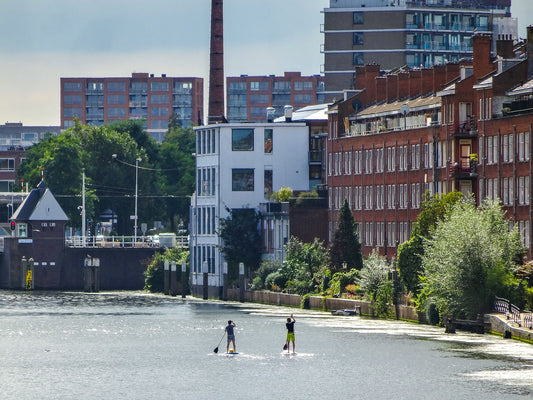Summer is finally here, with longer days and an irresistible call for outdoor activities. Paddleboarding is the perfect getaway, so you set out on a quest for your first inflatable board. The process can feel like a jungle. When starting something new, budget is often a key consideration. But before you rush to grab the first inflatable at your local supermarket or search for the cheapest alternative online, here are some points to consider:
Volume: Float Like a Boss
The volume of a board, measured in litres, determines how well it floats. The higher the volume, the more weight the board can support. Most boards also list a maximum weight capacity. Pay attention to the volume of the board if you’re on the heavier side or plan to share the board. A little extra volume never hurts.
Length: Size Does Matter
Boards between 10-12 feet in length are versatile for all-around use. If you have grand visions of touring or simply want to glide like a dream, opt for a minimum length of 11 feet. Longer touring and racing boards often have a pointy nose, providing speed and good tracking. An all-around board is always a safe bet, but don't be surprised if you outgrow it sooner than expected.
Paddle: The Perfect Partner
If you opt for a package deal, a three-piece, adjustable alloy paddle is often included. They are good for entry level, durable, but also heavy enough to double as anchors. If your budget allows, check if the shop offers the possibility to upgrade the paddle to a lighter version. Alternatively, you can upgrade later. It's always handy to have an extra paddle floating around.
Leash: Stay Connected, Stay Safe
Don't forget your leash and wear it proudly. It keeps you and your paddleboard together if things don't go to plan. Different paddling environments and conditions call for different leashes. For calm waters, a coiled leash is your friend, preventing it from dragging in the water and tripping you up. But if you're tackling moving waters, opt for a quick-release waist leash. Safety first, folks! We also recommend wearing a buoyancy aid or PFD, no matter how strong you think you are at swimming.
Air Pressure: Inflation Innovation
A top-quality iSUP is designed to manage at least 15 psi when fully inflated. The higher the psi, the smoother the rider, because nobody likes a floppy board. The more rigid the board, the better it performs. Don't settle for anything that can't manage 15 psi. We're talking about those flimsy banana boards you sometimes see at beaches. Leave those for the monkeys.
Standard Fin Box: Box It Up
SUP fins have an impact on manoeuvrability and tracking. We prefer US standard centre fin boxes. This nifty feature allows for easy replacement or upgrading of the fin. You might just find yourself needing a river fin for shallow waters or weedy summer canals.
Essential Accessories: Keep Connected, Stay Dry
Safety should always be a priority when paddleboarding. Carry a mobile phone in a waterproof case to stay connected and have the means to call for assistance if needed. In the event of separation from your SUP, having a protected phone can be a lifeline. Also consider bringing a drybag for your personal belongings, so that your essentials stay safe and dry throughout your adventures.
We hope these points help you navigate the treacherous waters of iSUP shopping and find the perfect first board. This may mark the beginning of a beautiful love affair with our favourite watersport. Paddleboarding is for everyone, regardless of where you shop or how much you spend. It's about the joy of being on the water and connecting with nature. Stay safe! Paddle within your ability, and if needed, take courses to help level up your skills.


No comments